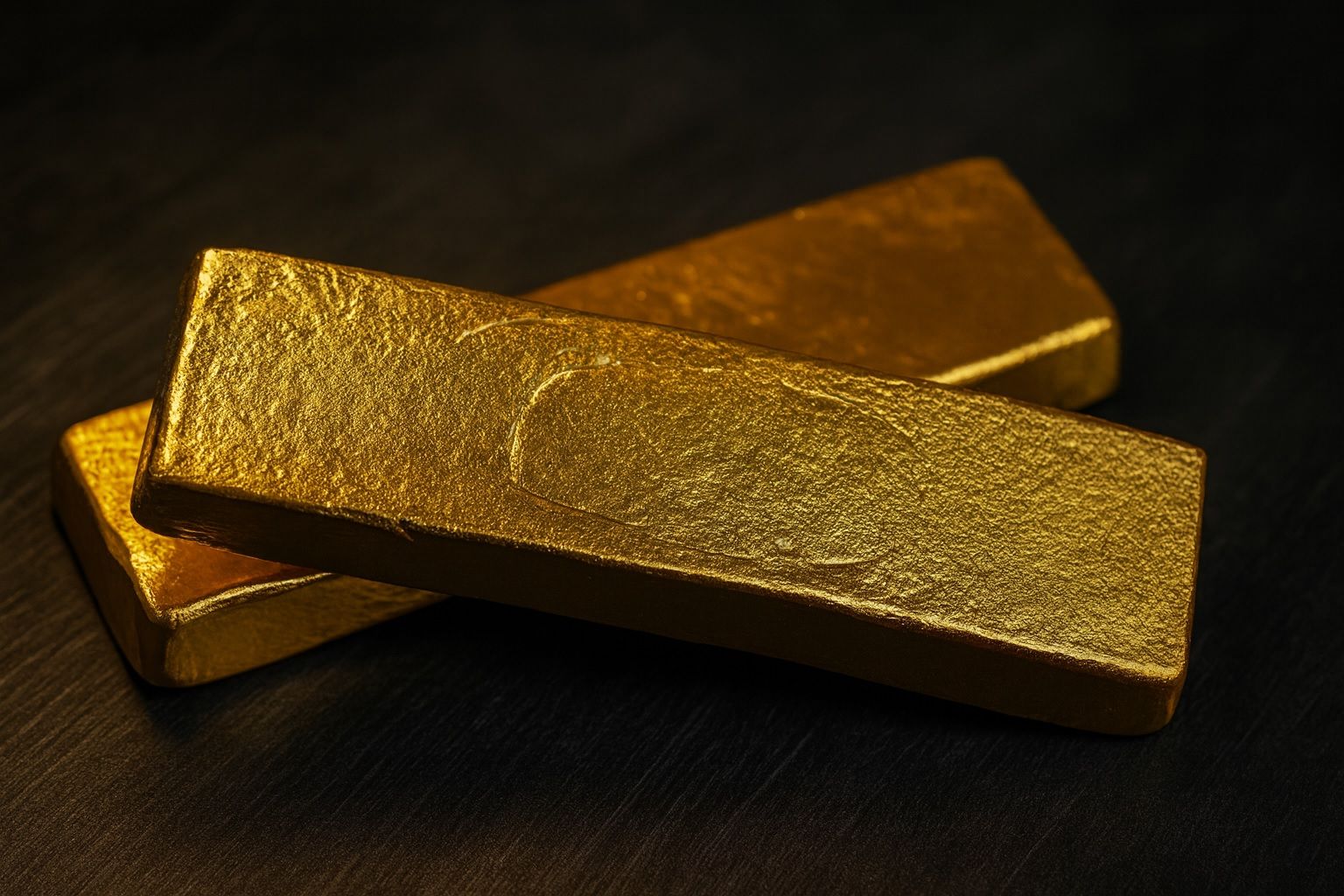Gold bullion bars: Gold prices have surged in 2025, repeatedly breaking records above $4,000 an ounce as economic uncertainties drive investors into safe-haven assets. The precious metal is up over 50% year-to-date – far outpacing stocks and most other assets [1]. However, after reaching an all-time peak of about $4,381/oz last week, gold has since pulled back slightly (now near $4,060) amid profit-taking and hopes of easing geopolitical tensions [2].
Key Facts
- Current Price & Recent High:Spot gold trades around $4,060/oz on October 27, 2025, down ~5% from its record high of $4,381.21 set last week [3]. Even after this dip, prices remain over 50% higher than at the start of the year – putting gold on track for its strongest annual performance since 1979 [4].
- Record Rally in 2025: Gold’s price skyrocketed through October, fueled by safe-haven buying. It repeatedly breached the $4,000 milestone for the first time ever [5], and at one point was up ~60% year-to-date [6]. The rally culminated in a peak near $4,380/oz, followed by a sharp one-day drop of over 3% – the steepest decline in ~5 years [7] – as some investors hurried to lock in profits. (TS2.tech reported scenes of New Yorkers lining up with bags of jewelry to cash out at the highs [8].)
- Safe-Haven Drivers:Global economic and political turmoil underpins gold’s ascent. Stubborn inflation, recession worries, and a “flight to safety” amid wars and conflicts (from Ukraine to the Middle East) have boosted demand [9]. Mounting U.S.-China trade tensions and a recent government shutdown in Washington added to uncertainty, sending investors toward gold as a hedge against risk [10] [11].
- Fed Policy & Interest Rates: Expectations of Federal Reserve rate cuts have been a major gold catalyst. With inflation easing and growth cooling, the Fed began trimming rates (after aggressive hikes in prior years), making non-yielding assets like gold more attractive [12]. Markets are pricing in another 0.25% rate cut at this week’s Fed meeting [13]. Lower interest rates (and a softer dollar) reduce the opportunity cost of holding gold, supporting its price [14].
- Central Banks & ETF Demand: Central banks worldwide are stockpiling gold, providing a strong tailwind. For example, China’s central bank has added to its gold reserves for 11 consecutive months through September [15]. Globally, official sector buying – partly to diversify away from the US dollar – is at multi-decade highs. Meanwhile, investors have poured money into gold-backed ETFs, with record inflows this year (over $60+ billion) shoring up demand [16].
- Latest Pullback Factors: Gold’s slight retreat in late October came as sentiment improved on other fronts. Hopes for a U.S.–China trade deal lifted stock markets and cooled safe-haven flows [17] [18]. At the same time, a temporary Israel–Hamas ceasefire and peaking Indian festival demand removed some immediate risk premiums. The dollar’s bounce from recent lows also made gold a bit pricier for overseas buyers, contributing to the consolidation [19] [20].
- Expert Outlook:Analysts are divided on what’s next. Some warn the rally may have overshot – “a good time to convert paper profit into real profit,” advises Gautam Shah of Goldilocks Research, anticipating further pullbacks [21]. Yet many others remain bullish. UBS’s Giovanni Staunovo notes that any positive trade news weighing on gold could be offset by the prospect of even looser Fed policy, which ultimately supports gold [22]. Indeed, dip-buyers quickly emerged after the recent slump, reflecting confidence that gold’s uptrend is intact. Major banks like HSBC and Bank of America now even predict gold could approach $5,000/oz by 2026, given the strong macro drivers [23].
- Gold Stocks & ETFs: The gold boom has lifted related assets. The largest gold ETF (SPDR Gold Shares, GLD) is up over 50% in the past year as investors flock to bullion [24]. Gold mining equities have soared – the S&P Global Gold Miners index jumped ~130% in 2025 [25], with giants like Newmont and Barrick doubling their share prices amid record profits [26]. However, the recent price correction hit miners hard: last week gold’s 6% one-day plunge (biggest since 2013) sent mining stocks tumbling by mid-single digits [27] [28]. Even after that pullback, gold miners and funds remain dramatically higher year-to-date, reflecting optimism in the sector.
Gold’s Record Run and Recent Pullback
After a steady climb all year, gold’s rally went into overdrive this fall. The metal broke one record high after another in early October, crossing the $4,000/oz threshold for the first time ever [29]. By mid-month it was hitting fresh peaks almost daily – spot gold reached about $4,318 on Oct. 16 and then an intraday record ~$4,381 on Oct. 20 [30]. At that level, gold had surged roughly 60% in 2025, making it one of the best-performing assets of the year [31].
This meteoric rise was followed by a burst of volatility. On Oct. 21, gold suddenly slid ~6% in a single session – the steepest one-day drop since 2013 [32]. Prices fell from the ~$4,380 high to around $4,203 amid a wave of profit-taking [33]. Traders said there was no single trigger; rather, after such a parabolic run-up, gold was primed for a technical correction [34]. Some pointed to hedge funds taking profits and even rumors of large sellers in Asia [35].
By the end of that week, gold stabilized near the low $4,100s – still an astoundingly high level historically (gold was ~$2,700 at the start of the year). To put it in perspective, the metal is on pace for its strongest year since 1979 [36], and it vastly outperformed equities, bonds, and other commodities in 2025 [37]. “Gold’s strength reflects an extremely positive macro backdrop for safe-haven assets,” notes Matthew Piggott of Metals Focus, referring to the unique convergence of factors lifting the metal [38].
This week, gold is hovering around $4,050–$4,100. In Monday’s trading, it dipped about 1–2% as news of a potential U.S.–China trade deal bolstered risk appetite and pulled some money into stocks [39]. President Trump signaled that the U.S. and China are poised to “come away with” a trade agreement in upcoming talks [40] – an announcement that normally might be bearish for gold. Indeed, Asian equity markets jumped on the détente hopes, while bullion temporarily lost a bit of its safe-haven sheen [41] [42].
However, analysts caution that gold’s pullback may be short-lived. “A possible trade deal is weighing on gold, but remember – lower tariffs could allow the Fed to cut rates further,” explains Giovanni Staunovo, commodity strategist at UBS [43]. In other words, an improving trade climate could give central banks more room to ease policy, which ultimately supports gold. Markets fully expect the Fed to cut rates by 0.25% on Wednesday at its policy meeting (following a similar cut in September) [44]. “Lower real interest rates should still support demand for gold,” Staunovo adds [45]. With that Fed decision and several other central bank meetings on deck this week, gold traders are staying cautious but prepared for the next move.
What’s Driving Gold’s Surge?
Gold’s spectacular run in 2025 has been powered by a perfect storm of economic and geopolitical factors. Several key drivers stand out:
- Federal Reserve Policy & Inflation: A major underpinning of gold’s rally is the shift in U.S. monetary policy. After years of rate hikes, the Federal Reserve has pivoted toward rate cuts as inflation shows signs of cooling. The first cut came in September, and another is expected imminently. Lower interest rates make gold – which yields no interest – relatively more attractive to hold [46]. They also tend to weaken the dollar, boosting dollar-priced gold. Meanwhile, even though inflation has eased from its peak, it remains above target; gold is seen as a hedge against the erosion of purchasing power during these uncertain times [47] [48]. Investors are betting that a “patient” or even dovish Fed will keep real yields low, a Goldilocks scenario for bullion [49].
- Geopolitical Uncertainty & Safe-Haven Demand: 2025 has been rife with global tensions, which have sent safe-haven flows pouring into gold. The ongoing war in Ukraine, intermittent conflicts in the Middle East (including a flare-up and ceasefire in the Israel–Hamas situation) [50], and U.S.–China trade disputes have all kept investors on edge [51] [52]. Political drama in Washington – from a government shutdown to contentious elections – further added to volatility [53]. Each crisis or conflict has driven anxious investors to seek shelter in gold, which is often called the “ultimate safe asset.” As one analyst put it, “Gold’s performance reflects a deeper loss of confidence in policymakers, currencies, and the financial system itself.” [54] In such an environment, demand for the metal soars whenever uncertainty spikes.
- Central Bank Buying & De-Dollarization: A less visible but hugely important force behind gold’s rise is massive buying by central banks. Nations have been increasing gold reserves at the fastest pace in decades [55]. China, India, Russia, Turkey, and others have led this trend, aiming to diversify away from the U.S. dollar and bolster financial security [56]. China, for instance, added to its gold stash for the 11th straight month as of September [57]. This official demand provides a consistent floor under gold prices. The World Gold Council noted central banks purchased record tonnages of gold in 2023–2024, and that wave has continued through 2025. “Central banks view gold as a hedge against currency and economic risks,” analysts say [58]. This de-dollarization push – intensified after Western sanctions froze Russia’s dollar reserves in 2022 – means central banks are effectively soaking up a significant share of global gold supply, tightening the market [59].
- Investor Inflows (ETFs and Funds): Beyond central banks, institutional and retail investors have also piled into gold through exchange-traded funds (ETFs) and other investment vehicles. Gold-backed ETFs have seen unprecedented inflows this year as the metal’s momentum attracted everyone from hedge funds to small savers [60]. Total holdings of gold ETFs worldwide hit an all-time high, with the value of assets under management surging to record levels [61]. Notably, the popular SPDR Gold Shares (GLD) fund has gained over 50% in the past 12 months [62]. Analysts say this reflects a broader shift – investors are treating gold less as a speculative trade and more as a core portfolio holding for stability [63]. “The market is accepting a new reality – a deeper loss of confidence in currencies and the financial system is driving long-term allocation to gold,” observes David Russell of GoldCore [64]. Additionally, gold’s rally has fed on itself: as prices rose, momentum traders and trend-following algorithms jumped in, adding further fuel.
- Dollar Weakness & Currency Hedge Appeal: The U.S. dollar’s value has an inverse relationship with gold. Earlier this year, the dollar index was strong, but in recent months it has softened – partly due to expectations of Fed rate cuts and huge U.S. fiscal deficits. A weaker dollar makes gold cheaper for overseas buyers, boosting demand [65]. Indeed, gold priced in other currencies (like euros, yen, and rupees) also hit record highs in 2025, underlining its broad strength. Conversely, brief bouts of dollar strength – such as during October’s middle when U.S. yields jumped – corresponded with modest gold pullbacks [66]. Many investors also see gold as a long-term currency hedge: when confidence in fiat currencies wavers (due to money printing or debt concerns), gold’s appeal grows. This year’s surge in government debt and ballooning fiscal deficits in the U.S. and elsewhere has amplified those worries [67], adding another layer of support for gold’s price as an alternative, hard currency.
All these factors combined have created a bullish feedback loop for gold. “The metal has been driven by geopolitical tensions, aggressive rate-cut bets, central bank buying, de-dollarisation and robust ETF inflows,” Reuters noted during gold’s climb [68]. Every time one driver cooled (for example, a temporary truce in a conflict), another (like trade or debt fears) would emerge, keeping gold’s safe-haven allure intact [69]. This synergy of drivers is why gold has managed to sustain such high price levels.
What Are Experts Saying?
Financial analysts and economists are actively debating how long gold’s rally can run – and how high it could ultimately go. Here’s a look at some key commentary and predictions:
- “Gold’s trajectory will hinge on the rate-cut picture heading into 2026 as well as developments around U.S.-China,” says Zain Vawda, analyst at OANDA. He notes that if trade tensions persist or worsen, that could “be the spark gold needs to cross the $5,000/oz barrier.” [70] Vawda also believes any short-term dips are likely to be temporary, as bullish investors use pullbacks to add positions [71].
- Giovanni Staunovo (UBS) points out the push-pull between geopolitics and monetary policy. A credible U.S.–China trade deal might reduce some immediate safe-haven demand for gold, “supporting risky assets and weighing on gold,” he says. “But potentially lower tariffs will allow the Fed to cut rates further,” which ultimately is gold-positive [72]. Staunovo expects lower real interest rates ahead to keep a floor under gold [73]. He doesn’t foresee a big drop around the Fed meeting since a cut is already priced in – unless the Fed’s tone changes markedly [74].
- Nitesh Shah (WisdomTree) highlights the shift in how investors view gold. “While jewelry demand may be weak at these prices, the official sector’s strategic purchases, together with retail and institutional flows, are now dominant drivers,” Shah observes [75]. In his view, gold’s 2025 run isn’t just a speculative spike but part of a structural reallocation into hard assets.
- Matthew Piggott (Metals Focus) underscores the macro backdrop: “Gold’s strength reflects an extremely positive macroeconomic and geopolitical background for safe-haven assets.” He notes that virtually no other major asset* came close to gold’s performance this year, which “shattered records” due to a “perfect storm” of inflation fears, war fears, and a pivot to easier monetary policy [76].
- Gautam Shah (Goldilocks Research) urges caution after the big run-up. “This is a good time to convert paper profit into real profit,” he advised when gold began slipping from its highs [77]. Shah argues the rally has been “too aggressive” and a deeper correction would be healthy. He also warned that silver’s surge (silver hit 14-year highs above $50/oz) could reverse similarly [78]. Some other strategists echo this, noting that each explosive move higher in gold is often followed by a pullback or consolidation phase [79].
On balance, sentiment among big institutions remains optimistic despite near-term volatility. In fact, many banks have been boosting their gold price forecasts as the year progressed. A recent Reuters poll of 39 analysts returned a median projection of $3,400/oz average for gold in 2025 and $4,275/oz in 2026 – the first time a Reuters consensus has topped $4,000 for a future year [80]. “Gold’s winning streak is seen extending into next year,” Reuters wrote, with most analysts citing sustained safe-haven demand amid economic and political turmoil [81].
Forecasts: How High Could Gold Go?
Major financial institutions and experts have laid out bold targets for gold in the coming months and years:
- HSBC: Raised its 2025 average gold price forecast to $3,455 and said $5,000/oz is possible in 2026 [82]. The bank expects the rally to continue into the first half of 2026, fueled by geopolitical risks, policy uncertainty, and high global debt levels [83].
- Bank of America: Likewise predicts gold around $5,000 by 2026, joining other banks in citing central bank buying and persistent inflation as drivers [84]. BofA analysts note gold’s status as a “core asset” has solidified, supporting higher long-term prices.
- Goldman Sachs: Recently upped its 12-month gold target to roughly $4,900 (from $4,300 prior) amid the metal’s blistering rally [85]. Goldman sees the uptrend moderating but continuing, given strong investment inflows and central bank demand.
- ANZ Bank: Forecasts gold will peak near $4,600 per ounce by June 2026 before cooling in the second half as the Fed’s easing cycle winds down [86]. In ANZ’s view, gold may crest in mid-2026 and then face headwinds if real interest rates start rising again.
- Reuters Poll: The consensus of analysts sees gold averaging $4,275 in 2026 (with peaks potentially higher) [87]. For 2025, the average forecast is $3,400 – implying prices staying around current levels on average, but with the possibility of new highs during the year. Notably, this poll’s 2026 outlook is 25% higher than what analysts predicted just three months ago [88], showing how quickly sentiment has shifted.
Even some high-profile figures outside of research departments are weighing in. JPMorgan CEO Jamie Dimon recently suggested that in the current environment, gold prices “could easily go to $5,000 or even $10,000” in the long run [89]. Such extreme predictions are outliers, but they underscore the extremely bullish tone in parts of the market. Most experts do anticipate more record highs ahead, albeit with the caveat that the journey may be choppy. “Persistent uncertainty will sustain support for the rally,” one commodities strategist said, “but we expect the pace to moderate.” [90]
Gold Stocks & ETFs: Riding High on the Golden Wave
The gold frenzy hasn’t been limited to the metal itself – it’s also supercharged gold-related stocks and funds. Investors who rode the gold wave via mining companies or ETFs have seen major gains (along with some stomach-churning swings last week).
Gold Mining Stocks: Gold miners tend to act as a leveraged play on gold, and 2025 proved this in dramatic fashion. With gold prices up over 50%, many mining stocks doubled or more in value [91]. For example, Newmont Corporation, the world’s largest gold producer, saw its share price climb over 100% year-to-date [92]. Barrick Gold and Agnico Eagle Mines similarly surged to multi-year highs, as higher bullion prices translated to fatter profit margins and record cash flows. The NYSE Arca Gold Miners Index (which tracks major miners) jumped roughly 130% in 2025, vastly outperforming the broader stock market [93].
Gold mining companies have capitalized on the rally by reining in costs and boosting output, further juicing their earnings. Analysts estimate many producers will report 50%+ profit growth this year thanks to gold’s price spike [94]. In fact, some miners’ earnings are rising even faster than their stock prices, implying still modest valuations if gold stays elevated. This dynamic had industry observers calling miners the “golden beneficiaries” of 2025 [95] – after several years of lagging the metal, the mining sector is now shining brightly.
However, the recent volatility in gold reminded investors that miners can fall just as fast on the downside. When gold plunged over 6% on Oct. 21, shares of major producers tumbled in tandem. Barrick, Newmont, and Agnico each slid roughly 5–7% that day [96], in what became the worst single-day rout for mining stocks since the 2020 pandemic crash (and for gold prices since 2013) [97]. The VanEck Gold Miners ETF (GDX), a popular fund tracking the sector, sank as well – though it remains up hugely on the year. Industry experts weren’t shocked by the correction; after such a relentless run, some froth had built up in mining equities. “Bull markets always need a healthy correction to weed out froth and ensure the cycle has duration,” notes Nicky Shiels, head of metals strategy at MKS Pamp [98]. She and other analysts see the dip as “healthy” if miners are to sustain their gains in the longer term.
Gold ETFs and Funds: The simplest way many investors play gold is through exchange-traded funds. The SPDR Gold Shares (GLD) – the largest physical gold ETF – has seen massive inflows in 2025. GLD’s price is up about 55% year-on-year [99], roughly mirroring gold’s rise (each share of GLD represents a fraction of an ounce of gold stored in a vault). GLD’s assets under management swelled to record levels above $70 billion, reflecting how popular gold ETFs have become as a go-to safe-haven investment [100].
For even more leveraged exposure, some investors turned to miners’ ETFs like VanEck Vectors Gold Miners (GDX) and Junior Gold Miners (GDXJ). These funds amplified the metal’s move – at one point, GDXJ (which holds smaller mining stocks) was up nearly 150% year-to-date. According to Leverage Shares data, gold mining ETFs have significantly outperformed the metal itself, thanks to miners’ high beta to gold prices [101]. Of course, that cuts both ways: during last week’s hiccup, GDX and GDXJ sank harder than gold. Still, for 2025 as a whole, anyone who held a broad basket of gold miners has enjoyed outsized returns.
Beyond miners, other gold-linked investments also benefited. Streaming and royalty companies (like Franco-Nevada and Wheaton Precious Metals) which finance miners in exchange for a cut of production, have seen their stocks climb strongly as well [102]. In Asia, even gold loan companies (which lend money against gold collateral) thrived as the value of that collateral soared [103]. On the flip side, jewelry retailers faced challenges – the high cost of gold dented consumer demand for jewelry, especially in price-sensitive markets. Many Indian jewelers, for instance, reported weaker sales volumes as customers adjusted to record gold prices [104] [105].
In summary, gold’s rally has been a bonanza for investors in bullion and mining shares, though not without brief jolts of volatility. The lesson for gold equity investors: when gold moves, miners tend to move more. As long as gold stays in an uptrend, these stocks and funds could continue to shine, but any reversal in gold would likely hit them quickly.
Investor Sentiment: Buy the Dip, or Time to Take Profits?
The breathtaking rise in gold has left investors debating whether to buy, sell, or hold at these lofty levels. Public sentiment reveals a mix of exuberance and caution:
On one hand, demand from retail buyers remains robust, especially on price dips. Across Asia and the Middle East, local media have reported people flocking to jewelry shops whenever gold eases from its highs. “Gold is the best investment,” a 57-year-old factory worker in Bangkok told Bloomberg, after rushing to buy gold when prices pulled back slightly [106]. In fact, when gold dropped in late October, queues formed outside gold dealers in cities from Singapore to Mumbai as everyday buyers tried to “buy the dip.” Some stores even ran out of popular small-bar sizes due to the surge in bargain-hunting demand [107]. This grass-roots appetite suggests many ordinary investors see any correction as a new opportunity to accumulate gold, rather than a reason to flee.
In the West, coin and bullion dealers also report strong sales. The U.S. Mint’s gold coin sales spiked during October’s rally and remained high into the dip, indicating steady retail interest. Gold’s cultural and emotional draw as a safe asset – often seen as a hedge against everything from inflation to political unrest – appears only reinforced by this year’s events. Google search trends for buying gold spiked to multi-year highs in 2025, and online gold trading platforms saw record new account sign-ups.
At the same time, some investors are indeed booking profits. Gold’s swift climb to $4k+ led savvy traders and even everyday people to take some money off the table. In New York’s famed Diamond District, jewelry shops saw lines of sellers bringing in gold heirlooms and scrap to cash in at record prices [108]. Armored trucks hauled away gold bars as dealers reported a wave of people eager to profit from the high prices (while perhaps planning to buy back later at lower levels) [109]. This kind of profit-taking is a normal dynamic in commodity markets: high prices encourage some selling (scrap supply increases, etc.), which can help cool the rally.
Wall Street professionals seem broadly optimistic that gold’s longer-term uptrend will continue, even if there are bumps along the way. “We expect de-risking and profit-taking by investors to be met by dip buying from other segments of demand – including central banks and physical buyers – ultimately keeping reversals relatively shallow,” says Gregory Shearer, a commodity strategist at JPMorgan [110]. In other words, when speculators sell, long-term players (like central banks or value investors) are ready to step in, preventing a steep crash. Indeed, that’s largely what happened during the October pullback – it found support quickly as bargain hunters emerged [111].
Still, prudence is in order after such a huge rally. Some advisors recommend that investors rebalance their portfolios if gold has grown to an outsized percentage. Taking at least partial profits can lock in gains and reduce exposure in case gold swings down. Others argue that holding a core position in gold is wise given today’s uncertainties, but new entrants might wait for further dips to buy rather than chasing the price at its peak.
Market veterans also draw parallels to past gold booms. In 2011, gold hit a then-record around $1,920 and subsequently spent years trading lower – catching out late buyers. However, many analysts say “this time is different” in terms of the macro backdrop. Unlike 2011, today we have synchronized global risks (persistent inflation, great power tensions, high debt) and a strong institutional bid (central banks, ETFs) supporting gold. “It’s hard to find a true gold bear among analysts right now,” notes an Economic Times report – virtually all forecasters see a higher average price next year, even if they underestimated how high 2025 would go [112].
The prevailing mood can perhaps be summed up as cautiously bullish. “Bull markets need healthy corrections,” as MKS Pamp’s Nicky Shiels says, but after a bit of cooling, “prices should consolidate and revert to a more measured bullish trajectory.” [113] Many experts advise using volatility to one’s advantage: “buy the dips” remains a common refrain [114]. Praveen Singh of Sharekhan, for instance, argues that the fundamental drivers for gold’s rise (like central bank buying and negative real rates) are intact, so any short-term sell-off is an opportunity to accumulate [115]. An analyst at IG Bank agreed, noting there’s “plenty of money ready to jump on the gold train” given the right entry point [116].
For investors, potential strategies depend on one’s outlook and risk tolerance:
- Long-term holders (Buy-and-Hold): If gold is a hedge in your portfolio, staying invested through the volatility makes sense, as the long-term trend is positive and gold provides diversification. Many are treating gold as a core “store of value” asset now rather than a trade [117].
- Dip Buyers: Those with conviction in gold’s bull market are keeping cash ready to add positions on any weakness. The ~$4,000 level is a new technical and psychological support; buyers stepped in around there during the latest dip. Should gold drop further (say towards $3,800), one might see even stronger buying from both retail and central banks, as JPMorgan’s outlook suggests [118].
- Profit Takers/Trimmers: After a 50–60% annual gain, taking some profits is a sensible risk management move. Traders are using options and futures to hedge downside, and some have rotated a bit from gold into other beaten-down assets. However, outright shorting gold has been a painful trade this year – few are willing to bet aggressively against it in this environment.
- Diversify within the Sector: Some investors shifted profits from gold into silver and other precious metals, which often lag gold’s moves. Silver hit a multi-year high above $54 before pulling back, and is up ~65% YTD [119]. Platinum and palladium also rose. Spreading exposure can mitigate risk if one metal corrects more than another.
Looking ahead, much will depend on how the global economy and geopolitics evolve in the coming months. The next catalysts on the radar include the Fed’s rate decisions (this week and in December), any concrete outcomes (or breakdowns) in U.S.–China trade talks, and the trajectory of inflation going into 2026. If inflation flares up again or a new crisis emerges, gold could resume its climb swiftly. Conversely, if peace deals or stronger economic growth reduce fear, gold might see more of a breather.
For now, gold holds near $4,000 – a level that seemed unthinkably high a year ago – with bulls and bears jockeying for momentum. The consensus among seasoned market watchers is that some volatility is inevitable, but gold’s fundamental supports (Fed easing, geopolitical uncertainty, robust demand) are likely to keep it buoyant. As the saying goes, “the trend is your friend,” and in gold’s case the trend in 2025 has been unmistakably upward. Whether that eventually carries the shiny metal to $5,000/oz and beyond is the next big question on everyone’s mind [120] [121] – one that will hinge on how this unique moment in economic history unfolds.
Sources: Gold market analysis by TS2.tech [122] [123]; Reuters gold price reports [124] [125]; Reuters October 2025 gold outlook poll [126] [127]; Bloomberg/Economic Times market commentary [128] [129]; Kitco/Reuters forecasts [130]; FinancialContent market report [131] [132].
References
1. ts2.tech, 2. www.reuters.com, 3. www.reuters.com, 4. www.reuters.com, 5. ts2.tech, 6. ts2.tech, 7. ts2.tech, 8. ts2.tech, 9. ts2.tech, 10. ts2.tech, 11. ts2.tech, 12. ts2.tech, 13. www.reuters.com, 14. ts2.tech, 15. ts2.tech, 16. ts2.tech, 17. www.reuters.com, 18. www.reuters.com, 19. www.reuters.com, 20. www.reuters.com, 21. ts2.tech, 22. www.reuters.com, 23. ts2.tech, 24. markets.financialcontent.com, 25. markets.financialcontent.com, 26. markets.financialcontent.com, 27. economictimes.indiatimes.com, 28. seekingalpha.com, 29. ts2.tech, 30. www.reuters.com, 31. ts2.tech, 32. economictimes.indiatimes.com, 33. ts2.tech, 34. economictimes.indiatimes.com, 35. economictimes.indiatimes.com, 36. www.reuters.com, 37. ts2.tech, 38. ts2.tech, 39. www.reuters.com, 40. www.reuters.com, 41. www.reuters.com, 42. www.reuters.com, 43. www.reuters.com, 44. www.reuters.com, 45. www.reuters.com, 46. ts2.tech, 47. ts2.tech, 48. www.reuters.com, 49. ts2.tech, 50. ts2.tech, 51. www.reuters.com, 52. www.reuters.com, 53. ts2.tech, 54. www.reuters.com, 55. ts2.tech, 56. ts2.tech, 57. ts2.tech, 58. ts2.tech, 59. economictimes.indiatimes.com, 60. ts2.tech, 61. markets.financialcontent.com, 62. markets.financialcontent.com, 63. www.kitco.com, 64. www.reuters.com, 65. ts2.tech, 66. ts2.tech, 67. economictimes.indiatimes.com, 68. www.reuters.com, 69. ts2.tech, 70. www.reuters.com, 71. www.reuters.com, 72. www.reuters.com, 73. www.reuters.com, 74. www.reuters.com, 75. www.reuters.com, 76. ts2.tech, 77. ts2.tech, 78. ts2.tech, 79. ts2.tech, 80. www.reuters.com, 81. www.reuters.com, 82. www.kitco.com, 83. www.kitco.com, 84. ts2.tech, 85. markets.financialcontent.com, 86. www.kitco.com, 87. www.reuters.com, 88. www.reuters.com, 89. www.kitco.com, 90. www.reuters.com, 91. markets.financialcontent.com, 92. markets.financialcontent.com, 93. markets.financialcontent.com, 94. markets.financialcontent.com, 95. markets.financialcontent.com, 96. seekingalpha.com, 97. economictimes.indiatimes.com, 98. economictimes.indiatimes.com, 99. markets.financialcontent.com, 100. markets.financialcontent.com, 101. leverageshares.com, 102. markets.financialcontent.com, 103. markets.financialcontent.com, 104. markets.financialcontent.com, 105. markets.financialcontent.com, 106. economictimes.indiatimes.com, 107. economictimes.indiatimes.com, 108. ts2.tech, 109. ts2.tech, 110. economictimes.indiatimes.com, 111. economictimes.indiatimes.com, 112. economictimes.indiatimes.com, 113. economictimes.indiatimes.com, 114. markets.financialcontent.com, 115. markets.financialcontent.com, 116. markets.financialcontent.com, 117. www.kitco.com, 118. economictimes.indiatimes.com, 119. ts2.tech, 120. www.reuters.com, 121. ts2.tech, 122. ts2.tech, 123. ts2.tech, 124. www.reuters.com, 125. www.reuters.com, 126. www.reuters.com, 127. www.reuters.com, 128. economictimes.indiatimes.com, 129. economictimes.indiatimes.com, 130. www.kitco.com, 131. markets.financialcontent.com, 132. markets.financialcontent.com








